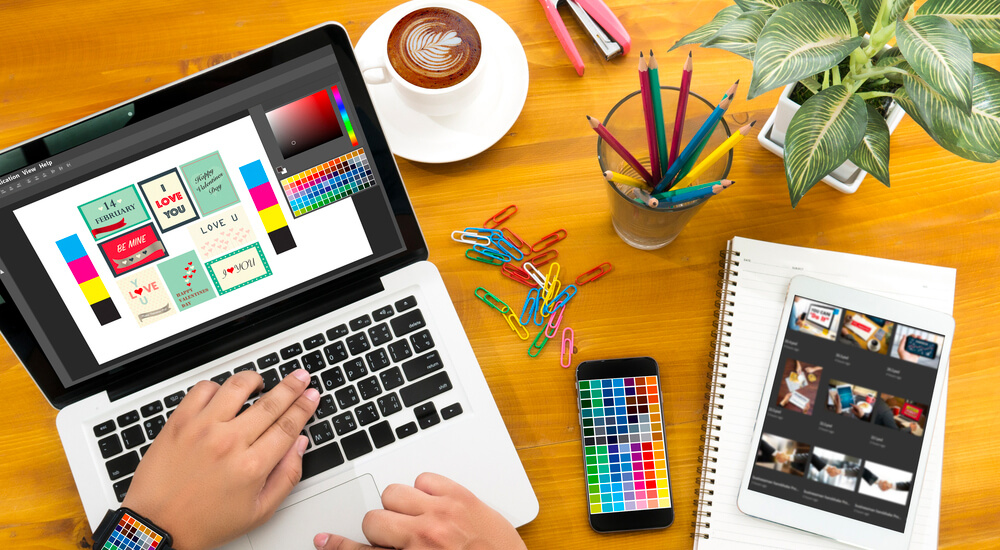Let's Talk
We would love to hear from you. Want to know more about our services or have any questions? Say Hi!
The fundamentals of design theory

If you’re a graphic designer working at a creative design agency an in-depth understanding of graphic design theory will enable you to communicate messages through visuals more effectively.
Design theory helps you with a clear understanding of design aesthetics & its principles that affect a spectator’s interpretations of the design.You can use it to understand how the patterns, colours, organization, and symmetry of your design, influence the way the audience perceives it.
Proper application of the design theory results in compelling design solutions, especially when utilized to propose a solution to the problem the consumer faces.
What are Design Principles?
Design principles are like the secret ingredients of any great design they’re the basic rules that guide how you arrange visual elements to create something that looks good and works well. Think of them as the foundation of any creative project, whether you’re designing a logo, a website, or a social media graphic. You must put these five design principles into practical use.
While each of these principles is intrinsic to a design, how they work together when communicating with a particular audience, is what matters most. Major creative design agencies make it a habit to stringently adhere to these five principles before initiating work on a new project.
5 Key Design Principles
1. Alignment
2. Repetition
3. Contrast
4. Hierarchy
5. Balance
Now let’s learn each principle in detail.
1. Alignment
Let’s imagine you come across a billboard banner or post that has an uneven alignment of graphics and text in relation to the various edges of the design canvas., would you really take your time to decipher its meaning? No, right?
The alignment of design elements gives life to cohesive design and visual connections. In addition to introducing a certain order to the overall design, it makes it easier and more comfortable for the viewer to understand the message that the design intends to convey.
For example- When reading a design with longer text, the left-aligned text would be easier to read than one with a center alignment.
Nevertheless, the center-aligned text is easier to read if the sentences are short. Hence, brands use central alignment for headings and slogans.
2. Repetition
As a common practice among graphic designers, repetition is widely used in marketing campaigns to acquaint the audience with the content.
Elements when repeated in a design, end up creating a sense of familiarity, which enables consumers to identify the brand easily.
Red and white, for example, are widely associated with the popular beverage brand ‘Coca-Cola’. It’s often the first image that comes to mind when seeing those colours together.
3. Contrast
When two opposite design elements are employed in a piece of design, for example, classic font and a contemporary font, or cool and warm colours, contrast occurs.
Using contrast in a design makes some of its specific aspects impactful while providing extra emphasis.
A creative may appear more positive if the designer employs more light colours than dark ones. As a result of this, viewers may be more likely to recognize an advertisement.
Graphic designers may use contrast in images in the following ways:
- Big pictures next to small ones
- Dark and light colours
- Faded and vibrant shades
- Warm and cool styles
- Classic and contemporary font
4. Hierarchy
A design’s visual hierarchy shows the order of importance and implies the connection of elements in order to create a coherent design. Visual hierarchy can help the audience understand the information easily.
You can shape users’ thoughts and lead them toward desired actions by arranging things logically and strategically. For instance-You must’ve noticed Billboards, Pamphlets, and Newspapers use larger elements in headlines or important parts, it is because size is arguably the most effective way to emphasize visual elements.
5. Balance
In a visual sense, balance relates to the distribution of objects, colours, textures, and spaces. In order to make a design feel stable, these elements should be balanced.
It contributes to the life, excitement and appeal of the design. You need these attributes to differentiate your brand from the competition and grab the attention of clients and customers.
The type of balance to use in your design depends on your goals for the image.
The elements used in both sides of the design must be similar in the case of a symmetrically balanced design. Asymmetrically balanced designs have sides that appear different yet are nevertheless pleasing. Radial balance involves similar elements arranged around a central point.
How to Put Design Theory to Practical Use?
Now that you’re aware of what design theory is you must be wondering how to make a difference using this knowledge?
According to Bauhaus’s theory, any prosperous design is based on the combination of form (design principles) with function (design purpose).
In layman’s terms, to create effective design solutions, you need to have a thorough understanding of both design theory and practical knowledge.
Art of Design Thinking
Design thinking revolves around the idea of solving the user’s problem, once you master the art of design thinking, it’ll help you use design theory more effectively.
Design thinking encourages you to humanize your design, it involves creating a design for a specific set of consumers and exploring different ways to captivate them through your design.
When you sit down to create something, the first question should always be what’s the problem that this is solving?
Put yourself in your customer’s shoes: Before you begin to work on a design for a project, you must understand who your target audience is. You must be able to do extensive research until you get a hold of your viewers’ preferences and needs.
Clearly illustrate the pain point: Based on your understanding of your audience, identify and define the problem your innovative design can resolve.
Let your creativity flow: Jot down ideas and concepts for your visual design to connect with the audience.
Give shape to your ideas: After you empty your mind on a sheet, the next step is to bring your brainstorming ideas to life. Using your list of ideas, select the design elements and materials you want to use.
Test your creation until perfection: Run your design past a small segment of your target audience to see how they react. In addition to providing feedback on areas of improvement, they can highlight your design’s strengths.
Conclusion
It’s absolutely essential for you to have a thorough understanding of graphic design theory and its various principles if you aim to grow your brand by reaching the right audience.
Litmus Branding, your one-stop creative design agency from India.


